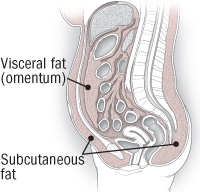Taking Aim at Belly Fat

Unlike fat parked on the hips and thighs, fat around the middle produces substances that can create serious health risks.
No matter what your body shape, excess fat isn’t good for your health. But saddlebags and ballooning bellies are not equivalent. When it comes to body fat, location counts, and each year brings new evidence that the fat lying deep within the abdomen is more perilous than the fat you can pinch with your fingers.
In most people, about 90% of body fat is subcutaneous, the kind that lies in a layer just beneath the skin. If you poke your belly, the fat that feels soft is subcutaneous fat. The remaining 10% — called visceral or intra-abdominal fat — lies out of reach, beneath the firm abdominal wall. It’s found in the spaces surrounding the liver, intestines, and other organs. It’s also stored in the omentum, an apron-like flap of tissue that lies under the belly muscles and blankets the intestines. The omentum gets harder and thicker as it fills with fat.
Although visceral fat makes up only a small proportion of body fat, it’s a key player in a variety of health problems.
As women go through their middle years, their proportion of fat to body weight tends to increase — more than it does in men — and fat storage begins favoring the upper body over the hips and thighs. Even if you don’t actually gain weight, your waistline can grow by inches as visceral fat pushes out against the abdominal wall.
